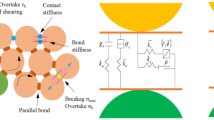Abstract
Due to the role of geological structure, the underground rock contains a large number of holes. In order to study the influence of the hole on the mechanical characteristics of the rock failure, the numerical simulation analysis of the intact rock and the rock with three shapes holes(circle, square, triangle) are carried out by using PFC2D. The results show that the rock strength varies with the shape of the hole. Circular holes have the least impact on strength and triangles have the greatest impact. At the same time, different holes shapes have different failure morphology, the intact rock sample forms a penetrating fracture zone inclined by 60°. For the circular hole, forms a through-fracture zone along the upper left and lower right corners. The square hole sample forms an "X"-shaped fracture zone along the four corners. For the triangular holes sample, the damage occurs first at the two positions of the left and right foot of the hole, and then the fracture zone is formed along the upper right corner and the two feet of the sample. Finally, theoretical analysis of stress distribution characteristics around the rock with circular holes is carried out. The compressive stress concentration occurs on the left and right sides of the circular hole, the tensile stress concentration occurs at the top and bottom boundary of the hole. And the tensile crack occurs at the top and bottom of the hole, tensile and shear mixed cracks appear on the left and right sides of the hole from numerical simulation. The crack distribution of numerical simulation is consistent with the theoretical stress analysis results.









Similar content being viewed by others
Data Availability
The data used to support the findings of this study are included within the article.
References
An B, Tannant DD (2007) Discrete element method contact model for dynamic simulation of inelastic rock impact. Comput Geosci 33(4):513–521
Bai Q S, Tu S H, Zhang C (2016) DEM investigation of the fracture mechanism of rock disc containing hole (s) and its influence on tensile strength. Theor Appl Fract Mech 86:197–216.
Chen ML, Jing HW, Ma XJ et al (2017) Fracture evolution characteristics of sandstone containing double fissures and a single circular hole under uniaxial compression. Int J Min Sci Technol 27:499–505
Castro-Filgueira U, Alejano LR, Arzúa J et al (2017) Sensitivity analysis of the micro-parameters used in a PFC analysis towards the mechanical properties of rocks. Procedia Eng 191:488–495
Erickson M, Durelli AJ (1981) Stress distribution around a circular hole in square plates, loaded uniformly in the plane, on two opposite sides of the square. J Appl Mech 48(1):203
Fakhimi A, Carvalho F, Ishida T et al (2002) Simulation of failure around a circular opening in rock[J]. Int J Rock Mech Min Ences 39(4):507–515
Fan X, Li K, Lai H et al (2018) Internal stress distribution and cracking around flaws and openings of rock block under uniaxial compression: a particle mechanics approach. Comput Geotech 102(10):28–38
Gui YL, Zhao ZY, Zhang C et al (2017) Numerical investigation of the opening effect on the mechanical behaviours in rocks under uniaxial loading using hybrid continuum-discrete element method. Comput Geotech 90:55–72
Itasca Consulting Group (2008) PFC2D (particle flow code in 2 dimensions) users guide. Itasca, Minneapolis
Liu W, Wang X, Li C (2019) Numerical study of damage evolution law of coal mine roadway by particle flow code (PFC) model. Geotech Geol Eng 37(4):1–9
Liu CW, Cao L, LIU S X, (2010) Method of equivalent radius for the analyzing rock stress of high-buried non-circular underground chambers. Copper Eng 1:1–5 ((in Chinese))
Lin P, Wong RHC, Tang CA (2015) Experimental study of coalescence mechanisms and failure under uniaxial compression of granite containing multiple holes. Int J Rock Mech Min Sci 77:313–327
Li DY, Zhu QQ, Zhou ZL et al (2017) Fracture analysis of marble specimens with a hole under uniaxial compression by digital image correlation. Eng Fract Mech 183:109–124
Liu JP, Li YH, Xu SD et al (2015) Moment tensor analysis of acoustic emission for cracking mechanisms in rock with a pre-cut circular hole under uniaxial compression. Eng Fract Mech 135:206–218
Potyondy DO, Cundall PA (2004) A bonded-particle model for rock. Int J Rock Mech Min Sci 41:1329–1364
Peng C, Liu W (2020) Study on failure mechanical characteristics and damage constitutive model of sandstone with different numbers of holes[J]. Latin Am J Solids Struct 17(5):1–15
Tao M, Zhao H, Li X et al (2018) Failure characteristics and stress distribution of pre-stressed rock specimen with circular cavity subjected to dynamic loading. Tunn Undergr Space Technol 81(11):1–15
Wang SY, Sloan SW, Tang CA (2013) Three-dimensional numerical investigations of the failure mechanism of a rock disc with a central or eccentric hole. Rock Mech Rock Eng 47(6):2117–2137
Wang X, Tian L (2018) Mechanical and crack evolution characteristics of coal–rock under different fracture-hole conditions: a numerical study based on particle flow code. Environ Earth Sci 77(8):297
Wang X, Wu N, Li H et al (2020) Influence of joint angle on the instability failure characteristics and AE evolution law of underground caverns[J]. Eur J Environ Civil Eng. https://doi.org/10.1080/19648189.2020.1837252
Yoshinaka R, Osada M, Park H et al (2008) Practical determination of mechanical design parameters of intact rock considering scale effect. Eng Geol 96(3–4):173–186
Acknowledgements
This work is financially supported by the National Natural Science Foundation of China (grant number 51078538).
Author information
Authors and Affiliations
Contributions
Chen Zhaofeng carried out numerical simulation and theroy analysis, writing the paper and Yonghui Shang edited the map and revised the language.
Corresponding author
Ethics declarations
Conflict of interest
The authors declare that they have no conflicts of interest.
Additional information
Publisher's Note
Springer Nature remains neutral with regard to jurisdictional claims in published maps and institutional affiliations.
Rights and permissions
About this article
Cite this article
Zhaofeng, C., Yonghui, S. Failure Mechanical Characteristics of Rock with Different Hole Shapes. Geotech Geol Eng 39, 3437–3447 (2021). https://doi.org/10.1007/s10706-021-01702-5
Received:
Accepted:
Published:
Issue Date:
DOI: https://doi.org/10.1007/s10706-021-01702-5




